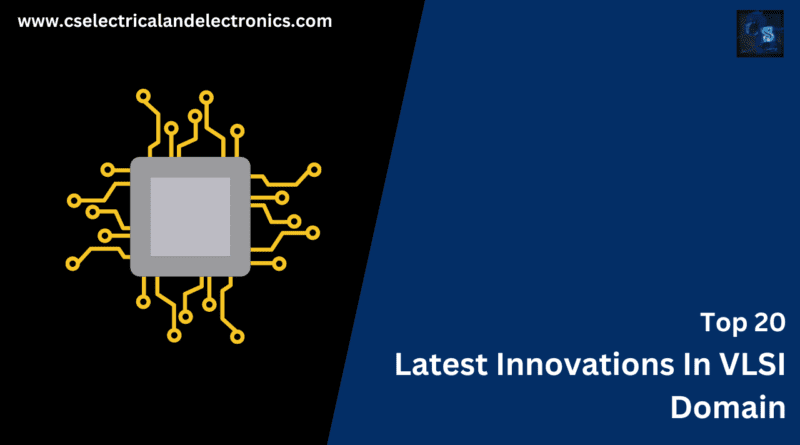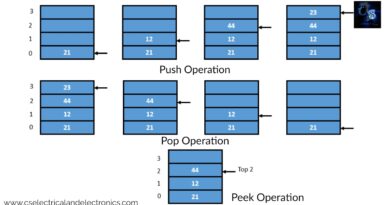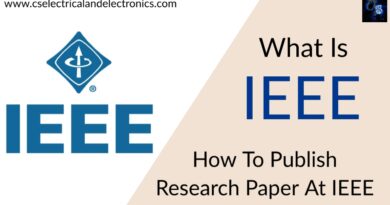Top 20 Latest Innovations In VLSI Domain, VLSI Technologies
Hello guys, welcome back to our blog. Here in this article, we will discuss the top 20 latest innovations in VLSI domain or VLSI technologies, and how these VLSI technologies will benefit the VLSI industry.
If you have any electrical, electronics, and computer science doubts, then ask questions. You can also catch us on Instagram – CS Electrical & Electronics.
Also, read:
- Types Of Electric Vehicle Charging Stations, Different Levels
- Types Of Testing Done After Software Development
- How Does Bike Airbag System Work, Bike Airbag Benefits
Latest Innovations In VLSI Domain
Very Large-Scale Integration, or VLSI, is the technical term for the process of building integrated circuits (ICs) with a very high density of transistors on a single chip. A single chip of semiconductor material, such as silicon, is used to create several components, including transistors, resistors, capacitors, and other devices, in the VLSI technology. Technology has transformed the world of electronics by making it possible to build sophisticated and potent electronic systems on a small scale.
The development of more powerful and sophisticated electronic devices, including computers, cellphones, and other digital systems, has been made possible by the advancement of VLSI technology, which has made it possible to make microchips that are ever more complicated.
Moreover, the integration of numerous functionalities on a single chip and the development of more effective and power-efficient electronic systems have also been made possible by VLSI technology.
VLSI technology is used in a wide range of industries, including computer, communication, healthcare, and consumer electronics. Advanced technologies like artificial intelligence, quantum computing, and the internet of things have resulted from it (IoT).
The top 20 recent developments in Very Large-Scale Integration (VLSI) are listed below:
20. 3D ICs:
Using numerous silicon wafers or chips, three-dimensional integrated circuits (3D ICs) build more complex and effective microelectronic devices.
19. Neuromorphic computing:
In order to build more effective and intelligent computer systems, neuromorphic computing uses circuits and architectures that are modeled after the composition and operation of the human brain.
18. Non-volatile memory:
A type of computer memory known as non-volatile memory keeps its data even when the power is switched off. High-capacity, low-power memory technologies like resistive random-access memory (RRAM) and phase-change memory have emerged as a result of innovations in this area (PCM).
17. Quantum computing:
Quantum computations make use of quantum-mechanical phenomena like superposition and entanglement. Qubits and quantum circuits with more qubits can be created thanks to recent developments in VLSI, which have facilitated the building of more potent quantum computers.
16. Graphene-based circuits:
With its application in high-speed and low-power circuits, graphene, a two-dimensional substance with great electrical and thermal conductivity, has the potential to transform the VLSI industry.
15. Silicon photonics:
Silicon is used in silicon photonics to build optical circuits that can send data at fast speeds across great distances while consuming little power. The creation of silicon photonic devices that are quicker and more effective is the result of recent developments.
14. Reconfigurable computing:
Field-programmable gate arrays (FPGAs), which may be dynamically changed to carry out various functions, are used in reconfigurable computing. This industry’s advancements have paved the way for the creation of flexible and efficient computer systems.
13. Biodegradable electronics:
Electronics that decompose or degrade naturally in the environment reduce electronic waste and pollution. The creation of biodegradable parts and circuits for use in medical implants and other applications is the result of recent advancements in VLSI.
12. In-memory computing:
Faster and more effective data processing is made possible by in-memory computing, which makes use of memory as the main processing component in a computer system. High-capacity, low-power in-memory computer devices have been created as a result of recent advancements in VLSI.
11. Edge computing:
Edge computing is the term for data processing that takes place nearer to the data source, at the edge of a network. The development of more effective and potent edge computing devices made possible by advancements in VLSI has made it possible to handle data in real-time applications like autonomous vehicles and smart cities more quickly and efficiently.
10. AI chips:
AI chips are specialized processors created to carry out machine learning tasks like speech and picture recognition. Recent developments in VLSI have produced more effective and potent AI circuits, enabling the creation of intelligent systems for a variety of applications.
09. Neuromorphic sensors:
Neuromorphic sensors enable more effective and intelligent sensing in robotics and other applications by mimicking the capabilities of the human eye and ear. The creation of more effective and power-efficient neuromorphic sensors has been made possible by recent advancements in VLSI.
08. Energy harvesting:
The practice of obtaining and storing energy from uncontrolled sources, such as light, heat, and motion, is known as energy harvesting. Recent advancements in VLSI have allowed for the creation of energy harvesting systems that are more effective and consume less power, paving the way for the creation of self-powered and low-power gadgets.
07. Wearable electronics:
Electronics that can be worn on the body, such as smartwatches and fitness trackers, are known as wearable electronics. Recent advancements in VLSI have allowed for the creation of wearable electronics that are more effective and power-efficient, paving the way for the creation of cutting-edge health monitoring systems and other applications.
06. Cyber-physical systems:
Intelligent systems that integrate both physical and digital components are known as cyber-physical systems (CPS). Recent advancements in VLSI have produced more effective and potent CPS, paving the way for the creation of sophisticated automation and intelligent industrial systems.
05. Hardware security:
In order to defend against cyber threats, hardware security entails the design and deployment of secure and reliable hardware solutions. Recent advancements in VLSI have facilitated the creation of more reliable and secure hardware systems, which in turn have facilitated the creation of more reliable and secure computer and communication systems.
04. Quantum-resistant cryptography:
A sort of encryption that is immune to attacks from quantum computers is known as quantum-resistant cryptography. The creation of more effective and potent quantum-resistant cryptography algorithms and devices has been facilitated by recent advancements in VLSI.
03. Advanced packaging:
Advanced packaging enables more effective and power-efficient electronic systems by integrating several chips and components into a single box. The development of more sophisticated and effective packing techniques, like chiplets and 2.5D/3D packaging, has been facilitated by recent advancements in VLSI.
02. ReRAM-based computing:
A non-volatile memory called resistive random-access memory (ReRAM) enables more effective and power-efficient computing systems by serving as both a memory and a compute component. ReRAM-based computer architectures and systems are now more advanced thanks to recent advancements in VLSI.
01. Neuromorphic computing with nanodevices:
Nanodevices like memristors, which are resistive devices that can change their resistance dependent on the input signals, can also be used to build neuromorphic computing. Nanodevice-based neuromorphic computing systems are now more effective and potent thanks to recent advancements in VLSI.
In conclusion, the development of increasingly sophisticated and potent microchips with several transistors on a single chip has been made possible by VLSI technology, which has transformed the world of electronics. With the use of this technology, electronic systems have become more effective and power-efficient, and several functions have been integrated into a single chip.
Recent advancements in VLSI technology have paved the way for the construction of cutting-edge technologies like artificial intelligence (AI), quantum computing, and the internet of things (IoT), which allow for the development of intelligent systems with sophisticated capabilities. VLSI technology is used in a wide range of industries, including computer, communication, healthcare, and consumer electronics.
VLSI technology will continue to be essential in enabling the development of cutting-edge technologies and ground-breaking applications as the demand for more potent and advanced electronic systems increases.
This was about “Latest Innovations In VLSI Domain“. I hope this article may help you all a lot. Thank you for reading.
Also, read:
- 100 (AI) Artificial Intelligence Applications In The Automotive Industry
- 100 + Electrical Engineering Projects For Students, Engineers
- 1000+ Electronics Projects For Engineers, Diploma, MTech Students
- 1000+ MATLAB Simulink Projects For MTech, Engineering Students
- 500+ Embedded System Projects For Engineer, Diploma, MTech, PhD
- 500+ Projects For Diploma Electrical, Electronics Student, Diploma Project
- 6G Technology: What To Expect Beyond 5G
- 8051 Microcontroller Timers, TCON Register, TMOD Register
Author Profile
- Chetu
- Interest's ~ Engineering | Entrepreneurship | Politics | History | Travelling | Content Writing | Technology | Cooking
Latest entries
 All PostsApril 19, 2024What Is Vector CANoe Tool, Why It Is Used In The Automotive Industry
All PostsApril 19, 2024What Is Vector CANoe Tool, Why It Is Used In The Automotive Industry All PostsApril 13, 2024What Is TCM, Transmission Control Module, Working, Purpose,
All PostsApril 13, 2024What Is TCM, Transmission Control Module, Working, Purpose, All PostsApril 12, 2024Top 100 HiL hardware in loop Interview Questions With Answers For Engineers
All PostsApril 12, 2024Top 100 HiL hardware in loop Interview Questions With Answers For Engineers All PostsMarch 22, 2024Driver Monitoring Systems In Vehicles, Working, Driver Sleepy Alert
All PostsMarch 22, 2024Driver Monitoring Systems In Vehicles, Working, Driver Sleepy Alert








